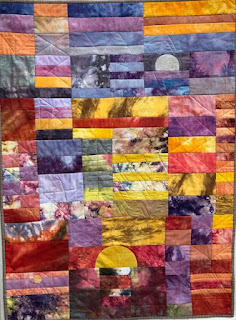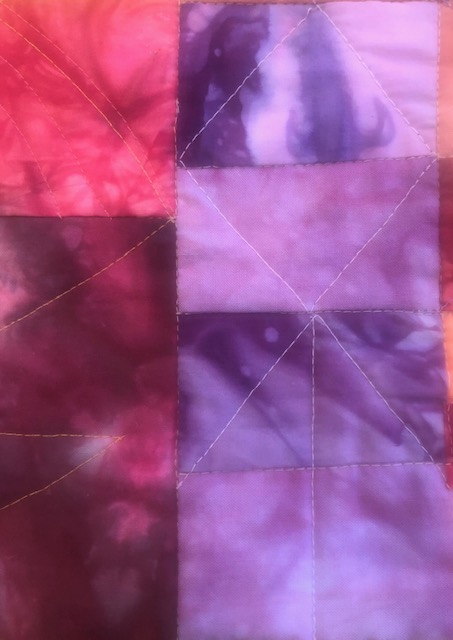https://researchdirect.westernsydney.edu.au/islandora/object/uws%3A12868
No call for vases or flowers this time. Outlines of birds with their wings outstretched in full flight became the subject matter, flying towards or across the light of a fecund full moon. Cut out in white silk and pale blue satin, the way the forms pick up the light gives a strange eeriness of gentle movement between the perspectival views of the background due to the nap of the fabrics. Light plays with the fabrics, such that some birds drop out of visibility as others emerge into sight. A pale grey binding seemed in order to suggest the cloud patterns and sky colours stretching in all directions.Tuesday, December 5, 2023
Flying high
Monday, November 13, 2023
Constructing a Crone quilt, for Jan Roberts
Wednesday, May 3, 2023
Vase #4: "Morning's twilight"
Thursday, April 27, 2023
Jean and Ben’s wedding gift quilt
Tuesday, April 18, 2023
vase #3: "Evening's twilight"
Wednesday, March 1, 2023
Sun-wise: 'the abominable Mystery'
Saturday, February 11, 2023
"Together apart: love always wins" (the final image)
Quilting with symbols
Here we go, with the aim to complete posts for this quilt as I seek to complete the 'topography' of the quilt. I have already ditch-quilted the strips to hold the three layers together before adding the final binding. Yep. I know - the wrong way round. But questions remain: how best to embed the symbols I’ve chosen – machine quilted, or hand-stitched? All layers have already been ditch stitched to hold the three layers together, so there is no quilting visible. Whether to use fine threads, or embroidery thread? I’m inclined to do both, as a mirroring process; but will too much special quilting detract from the overall impact? Practical thought comes to mind: machine stitching is so much faster (and other designs are on the back burner).
 |
Runes are another familiar set of ‘alphabet’ symbols originating long before lineal script, in the areas in northern European continent of Germanic and Viking peoples, who associated them with their god Odin. By expressing human qualities and characteristic emotions, they were used largely for divination – or as some say, the powers of cosmological principles. The word 'rune' acknowledges the ‘mystery’, the secret that is deeply embedded in the human psyche imparted from a relationship to the wider cosmos, as well as physical attributes related to fertility, continuity and abundance.
As symbolic sources of spiritual energies I have used Runes over the years as a form of guidance in recognising and then directing my own energies. Why not now, in the process of quilting the current creation? I haven’t pulled them out of their bag, as I used to do but have looked at them by deliberately choosing the most appropriate to represent the stage of my journey in the here and now. These symbols are perfect for straight-line quilting, being formed by various angles. The human attributes embedded in and held by the quilt in its creation are: joy, strength, warrior, opening, breakthrough, harvest, wholeness of coming to the Self. And there are other indigenous symbols, for water andAncient symbols have carried over into other cultural institutions. The hexagram is the six-pointed star, formed by two interlocking equilateral triangles, one pointing up the other downwards. Used in many cultures and religious beliefs, it can be representing male and female in perfect harmony; as above, so below – the human position between earth and the cosmos; and the interconnection between opposites, dark and light. Overlapping hexagrams (as fractals) result in numerous intersecting points that resonate higher energy frequencies, thereby forming downward pointing several diamond shapes of the sacred vulva of rebirth.
 |
Another form of star that has evolved with significant meaning in different contexts is the five pointed star. For example, as the Eastern Star of five points in Masonic symbolism expresses the importance of knowledge that is a guide to spiritual fulfillment and self knowledge. Called a pentacle in pagan earth-centred spiritual traditions depictions and rituals over millennia, it is often contained by a circle (reminding me of the DaVinci man), each point touches the diameter. It is also the way that I like to sign the first letter of my name 'A', which is easily struck in five strokes of the pen.
There are other maybe less familiar symbols used to quilt the quilt layers, from those used by the guild of stonemasons who built the magnificent cathedrals of the middle ages that are still standing today, using set square and compass. They are evidence of the geometric shapes that have deep metaphysical meaning behind them, used to explain the mathematics of the Universe. Besides being beautiful structures, they often have interesting mathematical properties and loads of history and symbolism. These geometric designs have been used by humans since ancient times in art, decor, and in religious and spiritual contexts that can be shared across artificial boundaries. They symbolically hold the values as they are expressed by the experiences and esoteric life-styles of individuals, while identifying and creating the universal patterns and energies that underlie and unify us all in Nature, and align consciousness to the infinite and eternal.
I'm finding it difficult to bring the quilting to an end, but I want to hang it and get on with the next - well, the others as yet unfinished - and I can always add more as the spirit moves. Throughout the process of creation, I contemplated many different names that related to the daily cycle of dawn and dusk, sunrise and sunset, following on from the original inspiration of the magnificent colours at all times of day. The moon and sun are both present, and considering their daily romantic dance of attraction to each other, I have decided on Together apart.
Internet is opting out for now, so will post final images tomorrow.
Monday, January 30, 2023
More on ways of seeing
This is still a work in process, though coming towards a conclusion. I have started towards quilting the three layers together... for next post.
 |
In order to construct that narrative visually, there is another need: to consider perspectives with regard to the fabric placement, and how they will tell their story. Will it have an aerial viewing point, as in many Indigenous works of the dot painting genre; or vertical/horizontal layered perspective – taking eye to move up and down and across? Or both? Is there to be a focal point, or several? David Hockney used a technique that he called 'joiners', based on the premise that singular and unified optical vision comes about through joining a series of multiple perceptions that come together to create the unified whole of normal vision.
Hockney’s ‘joiners’ aim to create an image able to show reality as we experience it – in fragments, rather than as a completed whole, but as part of the passage of time. It is brought about by collage, using two or several separate images of a single scene by overlapping them or forming a geometric grid. As a composite of a single scene, the image nevertheless has a single narrative that is not static, but engages a roving eye that darts from one area to another. The effect is to alter the usual ‘realism’ that creates the illusion of depth of field. And the aim of his joiners is to reflect the real process of seeing, one based on visual experience as the eye moves across multiple plains, having fluid and multiple viewing points. Unlike the perspective that arrives at the destiny of the vanishing point, the eye moves around, back from the point on the horizon towards the multitudes of vision closer to the viewer, taking her in as a participator as the viewpoint shifts.
Hockney's Bigger Grand Canyon in the collection of the Australian National Gallery is a notable example of his joiners, being made up of 60 canvases joined to create a work of 7.4 metres in width. It uses a reverse perspective to draw the viewer into the environment being depicted, rather than looking in from the outside. This form of ‘reverse perspective’ creates a viewing point, one that draws the viewer into the scene that has been achieved in traditional Chinese art by using the diagonal to cut across the distance perspective attained in Western realism art. His fascinating work on the use of linear perspective is Secret Knowledge: rediscovering the lost techniques of the Old Masters (2001, Thames and Hudson), detailing the use of optical devices over the centuries during the Renaissance to create photographic images for patrons in particular.
































